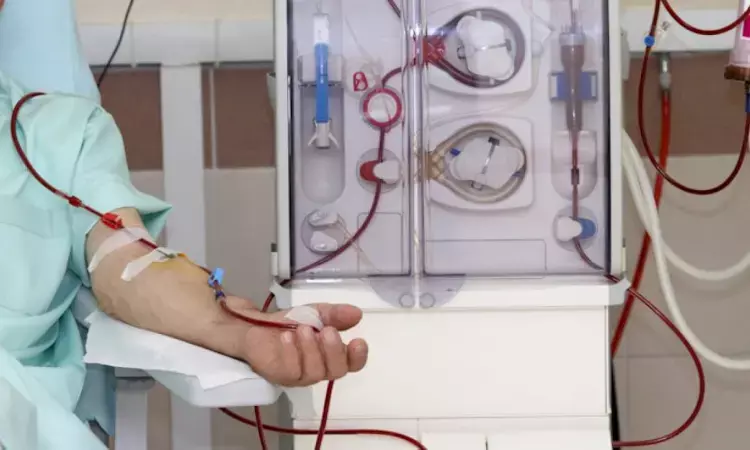- Home
- Medical news & Guidelines
- Anesthesiology
- Cardiology and CTVS
- Critical Care
- Dentistry
- Dermatology
- Diabetes and Endocrinology
- ENT
- Gastroenterology
- Medicine
- Nephrology
- Neurology
- Obstretics-Gynaecology
- Oncology
- Ophthalmology
- Orthopaedics
- Pediatrics-Neonatology
- Psychiatry
- Pulmonology
- Radiology
- Surgery
- Urology
- Laboratory Medicine
- Diet
- Nursing
- Paramedical
- Physiotherapy
- Health news
- Fact Check
- Bone Health Fact Check
- Brain Health Fact Check
- Cancer Related Fact Check
- Child Care Fact Check
- Dental and oral health fact check
- Diabetes and metabolic health fact check
- Diet and Nutrition Fact Check
- Eye and ENT Care Fact Check
- Fitness fact check
- Gut health fact check
- Heart health fact check
- Kidney health fact check
- Medical education fact check
- Men's health fact check
- Respiratory fact check
- Skin and hair care fact check
- Vaccine and Immunization fact check
- Women's health fact check
- AYUSH
- State News
- Andaman and Nicobar Islands
- Andhra Pradesh
- Arunachal Pradesh
- Assam
- Bihar
- Chandigarh
- Chattisgarh
- Dadra and Nagar Haveli
- Daman and Diu
- Delhi
- Goa
- Gujarat
- Haryana
- Himachal Pradesh
- Jammu & Kashmir
- Jharkhand
- Karnataka
- Kerala
- Ladakh
- Lakshadweep
- Madhya Pradesh
- Maharashtra
- Manipur
- Meghalaya
- Mizoram
- Nagaland
- Odisha
- Puducherry
- Punjab
- Rajasthan
- Sikkim
- Tamil Nadu
- Telangana
- Tripura
- Uttar Pradesh
- Uttrakhand
- West Bengal
- Medical Education
- Industry
Increased risk of acute kidney injury associated with chronic obstructive pulmonary disease: Study

A new study published in the journal of Renal Failure showed that patients with chronic obstructive pulmonary disease (COPD) have a high risk of acute kidney injury (AKI) and acute kidney disease (AKD).
About 50% of patients in intensive care units and 7%–18% of hospitalized patients suffer from acute kidney damage, which is linked to poorer clinical outcomes and increased mortality. The association between COPD, renal function, and mortality is highlighted by the prognosis of patients with AKI who have COPD. After acute kidney injury (AKI), persistent renal pathophysiological processes are referred to as acute kidney disease. The Kidney Disease: Clinical Practice Recommendations for Improving Global Outcomes (KDIGO) recommendations from 2012 state that AKI is characterized by a reduction in urine output (<0.5 mL/kg/h) within 7 days or a 1.5-fold rise in serum creatinine (Scr) from baseline.
The patients with chronic obstructive pulmonary disease and the mortality rate from COPD based on acute/subacute renal damage are poorly understood in relation to acute kidney injury (AKI) and acute kidney disease. Using online apps for clinical decision-making, this study creates machine learning models to predict AKI, AKD, and mortality in patients with COPD.
This study included 2,829 inpatients from January 2016 to December 2018. 20% of the data was used for testing, while the remaining 80% was used for training. Model performance was assessed using a variety of measures, and 8 machine learning techniques were employed. The decision-making process was shown using SHAP. Web apps for detecting high-risk patients were developed using the top models, as determined by AUROC.
AKI and AKD had incidence rates of 13.71% and 15.11%, respectively and 4.84% was the total mortality rate. With AUROC values of 0.815, 0.827, and 0.934 in AKI, AKD, and mortality, respectively, LightGBM demonstrated the greatest performance. Scr, neutrophil percentage, cystatin c, BUN, and LDH were important predictors of AKI. Age, AKI grade, HDL-C, Scr, and BUN were the main predictors of AKD.
The usage of dopamine and adrenaline medications, cystatin C, albumin, renal function trajectory, and neutrophil percentage were the main predictors of death. The prediction procedure for each patient was shown visually by force charts. Overall, patients with COPD have a notable incidence of AKI and AKD. Trajectories of acute and subacute renal damage are essential for forecasting death in individuals with COPD.
Source:
Jin, M., Ma, L., Li, B., Huang, X., & Chen, M. (2025). Comparative analysis of left atrial volume and strain parameters in hemodialysis vs. peritoneal dialysis patients using four-dimensional automatic quantification technology. Renal Failure, 47(1), 2485390. https://doi.org/10.1080/0886022X.2025.2485390
Neuroscience Masters graduate
Jacinthlyn Sylvia, a Neuroscience Master's graduate from Chennai has worked extensively in deciphering the neurobiology of cognition and motor control in aging. She also has spread-out exposure to Neurosurgery from her Bachelor’s. She is currently involved in active Neuro-Oncology research. She is an upcoming neuroscientist with a fiery passion for writing. Her news cover at Medical Dialogues feature recent discoveries and updates from the healthcare and biomedical research fields. She can be reached at editorial@medicaldialogues.in
Dr Kamal Kant Kohli-MBBS, DTCD- a chest specialist with more than 30 years of practice and a flair for writing clinical articles, Dr Kamal Kant Kohli joined Medical Dialogues as a Chief Editor of Medical News. Besides writing articles, as an editor, he proofreads and verifies all the medical content published on Medical Dialogues including those coming from journals, studies,medical conferences,guidelines etc. Email: drkohli@medicaldialogues.in. Contact no. 011-43720751


